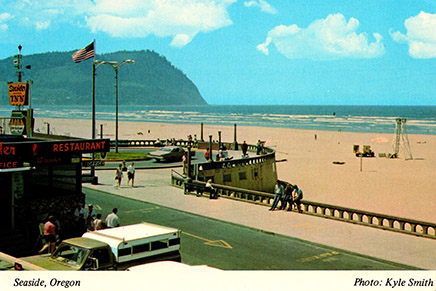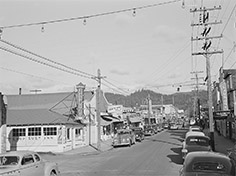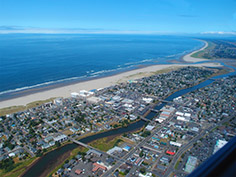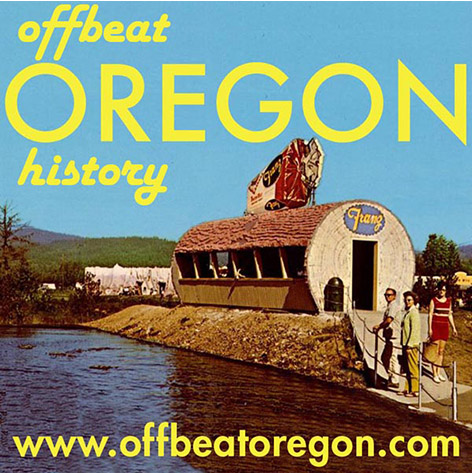CONTINUED FROM THE PRINT EDITION:
Seaside ’60s beach-party riots: ‘Gidget Runs Amok’
The police, outnumbered and more than a little freaked out, responded by basically nabbing random kids and hauling them off to the jail. Billy clubs and hazelwood ax handles got used for crowd control. The kids responded by ripping apart fences and benches to get cudgels to fight back with, and filling beer bottles with sand and lobbing them at the cops like hand grenades. At one point, someone talked the volunteer fire department into showing up and blasting the rioters with fire hoses; the kids charged, drove the firemen off, seized the hoses, and started blasting the cops with them. Then someone got the idea of stealing the lifeguard tower off the beach and dragging it into town. There it fell over, breaking a rioter’s leg. On Sunday, more cops came to town, and waded into the sea of drunken youths clobbering them with ax handles — usually striking the meaty part of the shoulder by the neck, so as to stun them without breaking collarbones or skulls — and drove them back to the beach. The crowd rallied and surged back into town, yelling and cursing and lobbing rocks and bottles. It was lather, rinse, repeat. On Monday, though, one of the state police guys had the idea of passing a kitty to hire The Fabulous Wailers, a popular Northwest regional band that had been booked to play a show at one of the clubs downtown. The Wailers’ show had been canceled because of the riots, and they were just hanging out in their hotel room trying not to get involved. The Wailers were happy to help, and so they set up their instruments and amplifiers on the roof of the beachside Pypo Club, an alcohol-free music venue for Seaside youths. And so the kids who had come to Seaside for a good time, stayed on the beach dancing and singing along to “Louie Louie” instead of running around town looking for cops to punch and throwing beer bottles full of sand through plate-glass windows. By the way, the Wailers had a new instrumental that they had written, and they played it for the first time at that beach party. They subsequently named it “Doin’ the Seaside,” and it later became one of their signature tracks. At the end of the day, the Wailers’ intervention had been a big success ... but Mayor Pysher and his supporters were furious. They had wanted those unruly teens taught a lesson, and instead they had been rewarded with a free rock concert. The move had the potential of becoming a big win-win for the town. But, it was not to be. The destruction and drama had made a lot of Seaside residents angry, especially the owners of the downtown businesses that the rioters had damaged and trashed. They did not want to send the message that they could be shaken down and have free rock concerts extorted from them by a pack of teenage hooligans. The way they saw it, Labor Day had always been crazy in Seaside — more trouble than it was worth, really, but they’d always sucked it up and endured it because hospitality was their town’s number-one thing, and they didn’t want to send a “stay away” type of message. Now they felt like their generosity was being taken for granted, like they’d bent over backwards to be good hosts and the guests had responded with humiliation and demands for more. Battle lines were drawn.
BY THE SPRING of 1963, it was clear that something had changed. The big crowds of visitors who usually flocked to Seaside for Spring Break didn’t show up. The locals figured that was fallout from the riots. Spring Break is a family holiday; what parent would want to take the gang to Ground Zero of the most destructive civil unrest in postwar Oregon history? And, that was probably the right call. Because when Labor Day rolled around again, the kids packed into the town like they always did — and another round of riots got started. But the crowds were smaller this time. Smaller, and more intense. The local kids who’d flocked to the scene to watch the riots the year before figured they’d “got the T-shirt” and didn’t need to see it again; the more harmless youths who were happy to go to the beach for a good time but didn’t want to get caught up in a mob opted to go play somewhere else.
|

That left a much higher concentration of angry young people who were coming to town to “get some action” in urban combat with the cops. If the police had been different in ’62 — tougher, more hard-nosed, less flexible — it was the crowd that was different in ’63, and the authorities were in for a nasty shock. Essentially, in ’62 the crowd had come to party, and the riot had taken everyone by surprise. In ’63, though, the crowd had come to riot. It was either baked into their plans for the weekend, or included as a strong possibility. Some of them were nursing grudges from the previous year, and others just wanted to fight. Not all the visitors were bloody-minded, but enough of them were to make for some very sharp action. There also were a lot of youths in the crowd who had just come to town to see Paul Revere and the Raiders play a concert at the Pypo Club, a large alcohol-free youth music venue, that weekend. The concert had been canceled, but the band was still in town, holed up in a hotel room; and the kids on the beach hoped if they made enough of a fuss, they’d get rewarded with another beach concert like last year. When it became clear that that would not happen, many of them got mad and joined the mob. Reinforced with National Guard troops and State Police troopers, the Seaside police thought they were ready for the renewal of hostilities; but it turned out they had only brought about half as much force as they’d need to tame the beast. And at the end of the weekend, as downtown business owners trudged back to work to clean up after the rioters, there was a sense of weariness. Was this going to be the new normal? A sluggish tourist season followed by three days of brick-throwing, slogan-chanting riots? People started pointing fingers. Pysher’s crew blamed outside agitators, younger townsfolk blamed Pysher’s crew of hard-nosed law-and-order types, and nearly everyone blamed the rioters’ parents for sparing the rod and spoiling the child. Even J. Edgar Hoover, the legendary capo dei capi of the FBI, got involved, probing the riots to see if he could detect the sinister hand of a communist plot behind it all. At that point, it was obvious to nearly everyone what had happened. Seaside’s reputation as a family-friendly resort town had been trashed, and the only demographic group that still seemed to want to come in large numbers was the rioters, and they’d be back in 1964 and probably more belligerent than ever. The town would have to be ready for them, and meet force with force. The mob would have to be vanquished. Then, they could get started rebuilding their battered reputation. And, well, that’s pretty much exactly what happened. The force of law-enforcement officers that came to Seaside in 1964 was big enough to keep control even when the furniture-burning, beer-guzzling hordes on the beach started chanting “Let’s riot! Let’s riot!” They made a few attempts, but there were plenty of cops and Guardsmen defending the town, and every time trouble broke out the mobs were consistently driven out of town and back onto the beach. On Monday it rained, and that was the end of that.
THE NEXT YEAR, 1965, there were a few scattered parties of youths on the beach around bonfires. They were visited by beach-patroling cops or Guardsmen at the first sign of trouble. Lots of citations for minor-in-possession were issued, but nothing resembling a riot happened. Seaside breathed a sigh of relief, and got busy rebuilding its battered reputation as a family-friendly beachside resort town. And, other than an out-of-control beach party that escalated to a brief “MTV Spring Break”-style rampage in ’99, the town has had no such trouble since.
|



